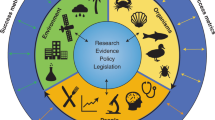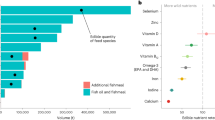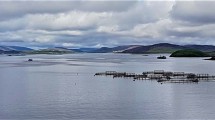Abstract
Aquatic foods are a critical source of human nutrition in many developing countries. As a result, declines in wild-caught fish landings threaten nutritionally vulnerable populations. Aquaculture presents an opportunity to meet local demand, but it also places pressure on natural resource inputs and causes a range of environmental impacts. Here, we examine whether current aquaculture systems in Bangladesh can be reoriented to address prevailing nutritional deficiencies while minimizing these environmental impacts. Current fish farming practices, even when optimized, cannot fully supply the same essential micronutrient densities of zinc, iron and calcium as wild-caught fish. However, when the proportion of highly nutrient-dense small indigenous fish species (SIS) was increased to at least 30% of the total output in any of the 14 aquaculture production systems analysed, these systems were able to meet or surpass the nutrient densities of average wild-capture fisheries. Extensive aquaculture systems that co-produce fish and rice had the lowest environmental burdens in six out of seven metrics examined when the composition of all aquaculture systems was modified to include 50% SIS. Nutrition-sensitive aquaculture that provides greater human health benefits and minimizes environmental impacts is a key societal challenge that requires targeted interventions and supportive policies.
This is a preview of subscription content, access via your institution
Access options
Access Nature and 54 other Nature Portfolio journals
Get Nature+, our best-value online-access subscription
$29.99 / 30 days
cancel any time
Subscribe to this journal
Receive 12 digital issues and online access to articles
$119.00 per year
only $9.92 per issue
Buy this article
- Purchase on Springer Link
- Instant access to full article PDF
Prices may be subject to local taxes which are calculated during checkout



Similar content being viewed by others
Data availability
The data used for the calculations and figures in this manuscript can be found in the Supplementary Data.
Code availability
All relevant code (in Matlab and R) is available from A.S. on request.
References
Golden, C. D. et al. Nutrition: fall in fish catch threatens human health. Nature 534, 317–320 (2016).
The State of World Fisheries and Aquaculture 2018 — Meeting the sustainable development goals (FAO, 2018).
Pauly, D. & Zeller, D. Catch reconstructions reveal that global marine fisheries catches are higher than reported and declining. Nat. Commun. 7, 10244 (2016).
Thilsted, S. H. et al. Sustaining healthy diets: the role of capture fisheries and aquaculture for improving nutrition in the post-2015 era. Food Policy 61, 126–131 (2016).
Pinstrup-Andersen, P. Nutrition-sensitive food systems: from rhetoric to action. Lancet 382, 375–376 (2013).
Phillips M., Subasinghe R. P., Tran N., Kassam L. & Chan C. Y. Aquaculture Big Numbers. FAO Fisheries and Aquaculture Technical Paper 601 (FAO, 2016).
Poore, J. & Nemecek, T. Reducing food’s environmental impacts through producers and consumers. Science 360, 987–992 (2018).
Hilborn, R., Banobi, J., Hall, S. J., Pucylowski, T. & Walsworth, T. E. The environmental cost of animal source foods. Front. Ecol. Environ. 16, 329–335 (2018).
Yosef, S., Jones, A. D., Chakraborty, B. & Gillespie, S. Agriculture and nutrition in Bangladesh: mapping evidence to pathways. Food Nutr. Bull. 36, 387–404 (2015).
ICDDR,B, UNICEF, Bangladesh, GAIN & Institute of Public Health and Nutrition. National Micronutrients Status Survey 2011–12 Final Report https://www.gainhealth.org/sites/default/files/publications/documents/bangladesh-national-micronutrient-survey-final-report-2013.pdf (GAIN, 2013).
FAO, IFAD, UNICEF, WFP & WHO. The State of Food Security and Nutrition in the World 2018. Building climate resilience for food security and nutrition (FAO, 2018).
Belton, B., van Asseldonk, I. J. M. & Thilsted, S. H. Faltering fisheries and ascendant aquaculture: implications for food and nutrition security in Bangladesh. Food Policy 44, 77–87 (2014).
Haque, M. D. et al. Factors associated with child hunger among food insecure households in Bangladesh. BMC Public Health 17, 1–8 (2017).
Bogard, J. R. et al. Higher fish but lower micronutrient intakes: temporal changes in fish consumption from capture fisheries and aquaculture in Bangladesh. PLoS ONE 12, e0175098 (2017).
Henriksson, P. J. G., Belton, B., Jahan, K. M.- & Rico, A. Measuring the potential for sustainable intensification of aquaculture in Bangladesh using life cycle assessment. Proc. Natl Acad. Sci. 115, 2958–2963 (2018).
Bogard, J. R., Marks, G. C., Mamun, A. & Thilsted, S. H. Non-farmed fish contribute to greater micronutrient intakes than farmed fish: results from an intra-household survey in rural Bangladesh. Public Health Nutr. 20, 702–711 (2017).
Bogard, J. R. et al. Nutrient composition of important fish species in Bangladesh and potential contribution to recommended nutrient intakes. J Food Compost. Anal. 42, 120–133 (2015).
Fiedler, J. L., Lividini, K., Drummond, E. & Thilsted, S. H. Strengthening the contribution of aquaculture to food and nutrition security: the potential of a vitamin A-rich, small fish in Bangladesh. Aquaculture 452, 291–303 (2016).
Toufique, K. A. & Belton, B. Is aquaculture pro-poor? Empirical evidence of impacts on fish consumption in Bangladesh. World Dev. 64, 609–620 (2014).
Castine S. A. et al. Homestead pond polyculture can improve access to nutritious small fish. Food Secur. 9, 785–801 (2017).
Ahmed B. N. & Waibel H. The role of homestead fish ponds for household nutrition security in Bangladesh. Food Secur. 11, 835–854 (2019).
Bogard J. R. et al. Inclusion of small indigenous fish improves nutritional quality during the first 1000 days. Food Nutr. Bull. 36, 276–289 (2015).
Karim M. et al. Carp–mola productivity and fish consumption in small-scale homestead aquaculture in Bangladesh. Aquac. Int. 25, 867–879 (2017).
Thilsted S. H. The potential of nutrient-rich small fish species in aquaculture to improve human nutrition and health. In Proc. Global Conference on Aquaculture 2010 (eds Subasinghe, S. et al.) 57–73 (FAO, 2012).
Jahan K. M., Belton B., Ali H., Dhar G. C. & Ara I. Aquaculture technologies in Bangladesh: an assessment of technical and economic performance and producer behavior. Program Report 2015-52 (WorldFish, 2015).
Chopin T., Cooper J. A., Reid G., Cross S. & Moore C. Open-water integrated multi-trophic aquaculture: environmental biomitigation and economic diversification of fed aquaculture by extractive aquaculture. Rev. Aquac. 4, 209–220 (2012).
Troell M. et al. Ecological engineering in aquaculture — potential for integrated multi-trophic aquaculture (IMTA) in marine offshore systems. Aquaculture 297, 1–9 (2009).
Troell, M. et al. Does aquaculture add resilience to the global food system? Proc. Natl Acad. Sci. 111, 13257–13263 (2014).
Gupta, S. & Banerjee, S. Feeding and breeding biology of Amblypharyngodon mola — a review. Int. J. Aquat. Biol. 2, 85–90 (2014).
Dasgupta, S., Hossain, M. M., Huq, M. & Wheeler, D. Climate change and soil salinity: the case of coastal Bangladesh. Ambio 44, 815–826 (2015).
Dasgupta S., Kamal F. A., Khan Z. H., Choudhury S. & Nishat A. River Salinity and Climate Change: Evidence from Coastal Bangladesh. Policy research working paper no. WPS6817 (World Bank, 2014).
Dasgupta, S., Hossain, M. M., Huq, M. & Wheeler, D. Climate change, salinization and high-yield rice production in coastal Bangladesh. Agric. Resour. Econ. Rev. 47, 66–89 (2018).
Ahmed, N. & Diana, J. S. Coastal to inland: expansion of prawn farming for adaptation to climate change in Bangladesh. Aquac. Rep. 2, 67–76 (2015).
Ali, H., Murshed-e-Jahan, K., Belton, B., Dhar, G. C. & Rashid, H. O. Factors determining the productivity of mola carplet (Amblypharyngodon mola, Hamilton, 1822) in carp polyculture systems in Barisal district of Bangladesh. Aquaculture 465, 198–208 (2016).
Ahmed, N., Troell, M., Allison, E. H. & Muir, J. F. Prawn postlarvae fishing in coastal Bangladesh: challenges for sustainable livelihoods. Mar. Policy 34, 218–227 (2010).
Red List of Bangladesh Volume 5: Freshwater Fishes (IUCN Bangladesh, 2015).
Kostori, F. A., Parween, S. & Islam, M. N. Availability of small indigenous species (SIS) of fish in the Chalan Beel—the largest wetland of Bangladesh. Univ. J. Zool. Rajshahi Univ. 30, 67–72 (2012).
Naylor, R. L. et al. Effect of aquaculture on world fish supplies. Nature 405, 1017–1024 (2000).
Ali, H., Rico, A., Murshed-e-Jahan, K. & Belton, B. An assessment of chemical and biological product use in aquaculture in Bangladesh. Aquaculture 454, 199–209 (2016).
Hamre, K. et al. Fish larval nutrition and feed formulation: knowledge gaps and bottlenecks for advances in larval rearing. Rev. Aquac. 5, S26–S58 (2013).
Kwasek K., Thorne-Lyman A. L. & Phillips M. Can human nutrition be improved through better fish feeding practices? A review paper. Crit. Rev. Food Sci. Nutr. https://doi.org/10.1080/10408398.2019.1708698 (2020).
Hernandez, R. et al. The “quiet revolution” in the aquaculture value chain in Bangladesh. Aquaculture 493, 456–468 (2018).
Hicks, C. C. et al. Harnessing global fisheries to tackle micronutrient deficiencies. Nature 574, 95–98 (2019).
Smith, M. R., Micha, R., Golden, C. D., Mozaffarian, D. & Myers, S. S. Global expanded nutrient supply (GENuS) model: a new method for estimating the global dietary supply of nutrients. PLoS ONE 11, e0146976 (2016).
Coates, J., Rogers, B. L., Blau, A., Lauer, J. & Roba, A. Filling a dietary data gap? Validation of the adult male equivalent method of estimating individual nutrient intakes from household-level data in Ethiopia and Bangladesh. Food Policy 72, 27–42 (2017).
Farmery, A. K., Gardner, C., Jennings, S., Green, B. S. & Watson, R. A. Assessing the inclusion of seafood in the sustainable diet literature. Fish Fish. 18, 607–618 (2017).
Gephart, J. A. et al. The environmental cost of subsistence: optimizing diets to minimize footprints. Sci. Total Environ. 553, 120–127 (2016).
Ara G. et al. Effectiveness of micronutrient-fortified rice consumption on anaemia and zinc status among vulnerable women in Bangladesh. PLoS ONE 14, e0210501 (2019).
Leyvraz M. et al. An assessment of the potential impact of fortification of staples and condiments on micronutrient intake of young children and women of reproductive age in Bangladesh. Nutrients 8, 541 (2016).
Perignon, M., Vieux, F., Soler, L. G., Masset, G. & Darmon, N. Improving diet sustainability through evolution of food choices: review of epidemiological studies on the environmental impact of diets. Nutr. Rev. 75, 2–17 (2017).
Bogard, J. R., Marks, G. C., Wood, S. & Thilsted, S. H. Measuring nutritional quality of agricultural production systems: application to fish production. Glob. Food Sec. 16, 54–64 (2018).
Institute of Medicine. Dietary Reference Intakes: the Essential Guide to Nutrient Requirements (The National Academies Press, 2006).
Allen, L., de Benoist, B., Dary, O. & Hurrell, R. (eds) Guidelines on Food Fortification with Micronutrients (WHO, FAO, 2006).
Vitamin and Mineral Requirements in Human Nutrition 2nd edn (WHO, FAO, 2004).
Smith, M. R. & Myers, S. S. Impact of anthropogenic CO2 emissions on global human nutrition. Nat. Clim. Chang. 8, 834–839 (2018).
Miller, L. V., Krebs, N. F. & Hambidge, K. M. A mathematical model of zinc absorption in humans as a function of dietary zinc and phytate. J. Nutr. 137, 135–141 (2007).
Hambidge, K. M., Miller, L. V., Westcott, J. E., Sheng, X. & Krebs, N. F. Zinc bioavailability and homeostasis. Am. J. Clin. Nutr. 91, 1478S–1483S (2010).
Eshel, G. A geophysical foundation for alternative farm policy. Environ. Sci. Technol. 44, 3651–3655 (2010).
Acknowledgements
A.S. and C.D.G. are supported by grants from The Nature Conservancy, Christopher Stix and Michelle Roman to the Harvard T.H. Chan School of Public Health. J.A.G. was funded by the US National Socio-Environmental Synthesis Center under funding received from the National Science Foundation DBI-1052875. P.J.G.H. is funded by FORMAS (2016-00227 and 2018-02318) and CGIAR Research Programs FISH and CCAFS. A.S. and P.J.G.H. thank the Kjell and Märta Beijer Foundation for supporting the Beijer Young Scholars network.
Author information
Authors and Affiliations
Contributions
All authors participated in the writing and editing of the manuscript and have approved the final version. A.S. assembled the data, conducted the analyses, and wrote and edited the original manuscript. All authors had full access to the data in the study and take responsibility for the integrity of the data and the accuracy of the data analysis. The corresponding author attests that all listed authors meet authorship criteria and that no others meeting these criteria have been omitted.
Corresponding author
Ethics declarations
Competing interests
The authors declare no competing interests.
Additional information
Publisher’s note Springer Nature remains neutral with regard to jurisdictional claims in published maps and institutional affiliations.
Supplementary information
Supplementary Information
Supplementary note, methods, Tables 1,2, Figs. 1,2, references
Rights and permissions
About this article
Cite this article
Shepon, A., Gephart, J.A., Henriksson, P.J.G. et al. Reorientation of aquaculture production systems can reduce environmental impacts and improve nutrition security in Bangladesh. Nat Food 1, 640–647 (2020). https://doi.org/10.1038/s43016-020-00156-x
Received:
Accepted:
Published:
Issue Date:
DOI: https://doi.org/10.1038/s43016-020-00156-x
This article is cited by
-
Integrated aquatic and terrestrial food production enhances micronutrient and economic productivity for nutrition-sensitive food systems
Nature Food (2023)
-
A Decision Framework for Selecting Critically Important Nutrients from Aquatic Foods
Current Environmental Health Reports (2023)
-
Nutrition-sensitive aquaculture in Bangladesh
Nature Food (2020)



